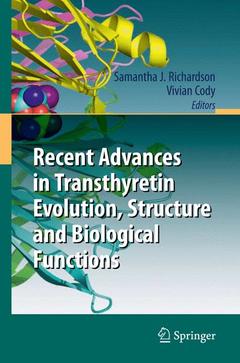Description
Recent Advances in Transthyretin Evolution, Structure and Biological Functions, 2009
Coordinators: Richardson Samantha J., Cody Vivian
Language: French
Subjects for Recent Advances in Transthyretin Evolution, Structure...:
Keywords
bacteria; biology; growth; hormone; mutation; neuropeptides; physiology; protein; protein structure; proteins; synthesis; thyroid hormone; Proteomics
Publication date: 11-2014
362 p. · 15.5x23.5 cm · Paperback
Publication date: 09-2009
362 p. · 15.5x23.5 cm · Hardback
Description
/li>Contents
/li>Comment
/li>
Transthyretin is a most exciting example for the study of the evolution of protein structure-function relationships
Covers both the basic and the clinical research into transthyretin
Brings the reader up to date on the latest developments and discoveries
These books may interest you

Retinoid Signaling Pathways 166.19 €

Thyroid Function Testing 116.04 €

RetinoidsMethods and Protocols 116.04 €

